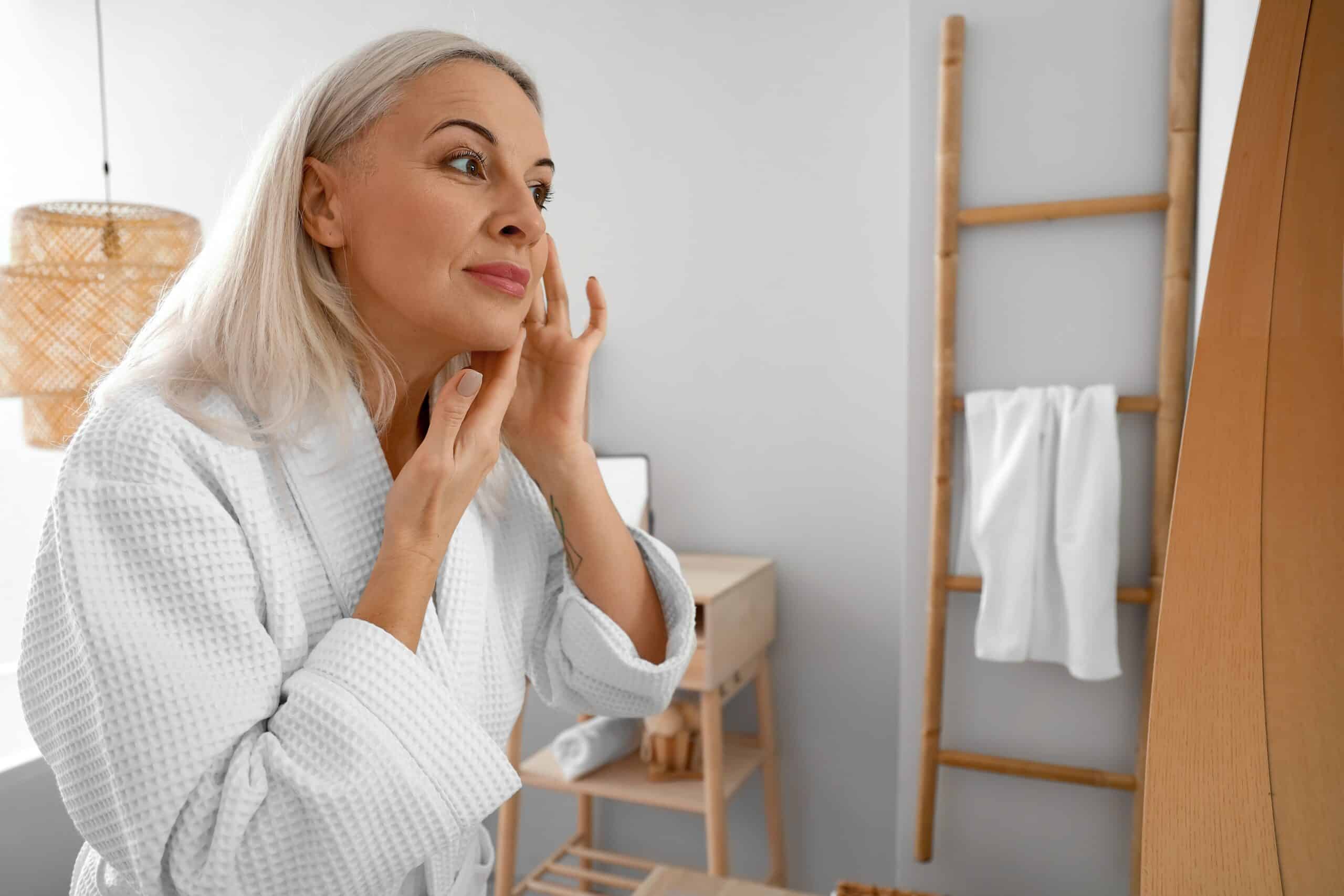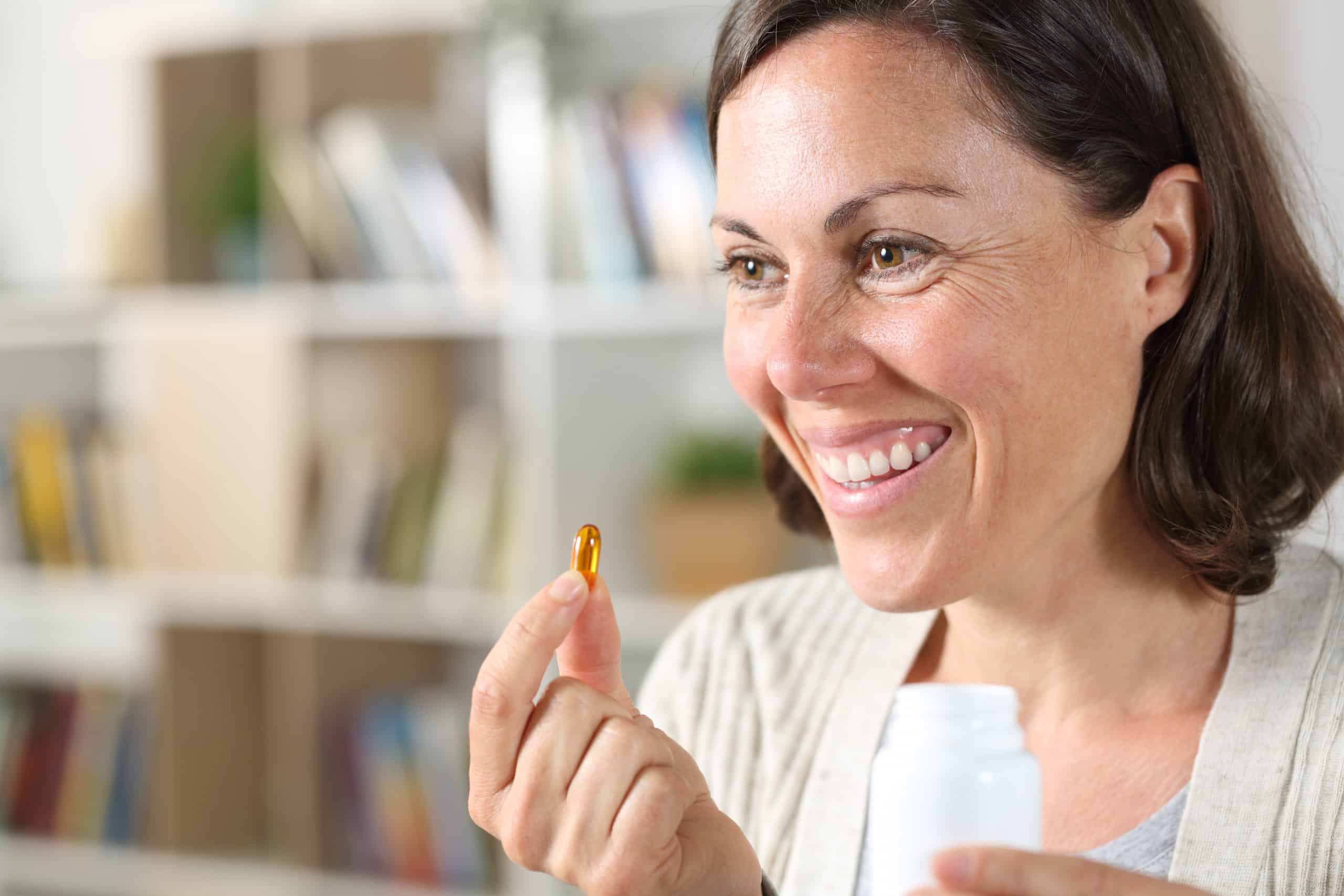Menopause Skin: How to Get Your Glow Back

By Christina Lyon
Listen—I get it. Your skin just isn’t what it used to be. A once glowing and smooth surface was replaced seemingly overnight by wrinkles, fine lines, and dryness. And don’t even get me started on the jawline facial hair.
Menopause isn’t kind to our complexion. But if you think your days of having dewy, gorgeous skin are behind you, think again. Aging may be inevitable, but how your skin ages is very much under your control.
Read on to get the lowdown on what happens to your skin during menopause and the steps you can take to revive your natural radiance.
What Happens to Skin During Menopause?
Healthy, glowing skin isn’t just a result of good genes and using the right skincare products. It’s also a sign of hormonal balance. So, when your estrogen levels start to decline during menopause, it’s not surprising that your skin changes, too.
Estrogen is responsible for keeping skin moist and supple, so when levels dip, skin can become dry, thin, and less elastic. Unfortunately, when estrogen declines, collagen production declines right along with it, resulting in more noticeable sagging and prominent wrinkles.
Adding insult to injury, menopause, perimenopause and even postmenopause can also cause hot flashes, night sweats unwanted dark spots, facial hair, and even post-menopausal breakouts. It’s no wonder we feel like our skin is betraying us.
Luckily, dermatology has come a long way. There are a number of things you can do to take care of your menopause symptoms and get your glow back.
How to Improve Menopause Skin: 5 Tips
Skincare after menopause is all about using the right ingredients to hydrate, protect, and nourish your skin. Follow these tips to reduce menopausal skin changes and restore your youthful complexion.

1. Give Yourself a Facial Massage
Facial massage is an easy, at-home way to stimulate collagen production and improve circulation. By gently massaging your face in a circular motion, you can help to increase blood flow, and promote lymphatic drainage. This will give your skin a healthy glow and help to reduce the appearance of fine lines and wrinkles.
Give yourself a daily facial massage with light oil or moisturizer. Use gentle circular motions, and be sure to massage upward from your neck toward your forehead. You can grab an affordable facial massaging wand or a classic gua sha tool, but for a more intensive treatment, invest in the NuFace. This device uses low-level electrical currents to take your facial massage to the next level, stimulating the skin for improved color and texture. It’s expensive but powerful, and if you’re already spending the time to do the massage, make the most of the minutes!
2. Up Your Moisturizer Game
Dry, menopausal skin needs all the hydration it can get. Look for a gentle, oil-free face moisturizer that contains hyaluronic acid, ceramides, or glycerin—ingredients that help skin attract and retain moisture. Find the best fitting lotion based on your skin tone from our curated favorites.
During your skincare routine, be sure to apply your moisturizing lotion while your skin is still slightly damp from cleansing to help seal in hydration. And don’t forget to moisturize your neck and chest—these dry skin areas are often neglected but can show signs of aging, too.
3. Hydrate on the Inside Too
Applying moisturizer to the outside of your skin is important, but what you put into your body is just as crucial for menopausal skin health. Be sure to drink plenty of water throughout the day to help keep your skin cells plump and hydrated.
If plain water isn’t your thing, try adding a slice of lemon or lime or infuse your water with fresh herbs like mint or cucumber. Also, eat plenty of fruits and vegetables that are high in water content, like cucumbers and watermelon.
4. Avoid Irritants
During menopause, skin can become more sensitive and reactive. To avoid irritation, look for skincare products that are labeled “hypoallergenic” or “for sensitive skin.” These products will usually be free of the fragrances, alcohol, and colors—often labeled as SD alcohol or denatured alcohol—that can irritate menopausal skin.
Avoid using harsh cleansers or exfoliants, and always use sunscreen with an SPF 30 or higher to protect your skin from damage.
5. Skip the Steamy Showers
Hot showers feel amazing, but they can be drying, especially for menopausal skin. To avoid stripping your skin of its natural oils, stick to warm water when cleansing or showering.
And when you’re done, pat your skin dry—don’t rub—and immediately hydrate your face with a light, oil-free moisturizer.
6. Treat Acne with a Gentle Touch
Acne is one of the very unfortunate side effects of the hormonal changes we experience in menopause. If you’re dealing with menopausal breakouts, resist the urge to zap your zits with the strongest spot treatment you can find. Harsh ingredients can irritate menopausal skin, making breakouts worse.
Instead, look for a gentle acne-fighting cleanser or spot treatment that contains salicylic acid or benzoyl peroxide. The iconic Mario Badescu Drying Lotion combines Salicyclic Acid, Sulfur, and Zinc Oxide for effective spot treatment. Apply at night on any active breakouts and wake up to dried, neutralized pimples. Throughout the day, take care not to touch your face, and be sure to moisturize afterward to help soothe any redness or irritation.
7. Stay Out of the Sun
Sun exposure can cause skin damage, dryness, and fine lines—especially for menopausal skin. To protect your aging skin against skin cancer, always wear sunscreen with an SPF of 30 or higher.
And if you’ll be spending time outdoors, seek shade whenever possible and cover up with clothing, a hat, or sunglasses.
Get The Finer Life
Our Sunday email has tips and content you will love – exclusively for our subscribers.
"*" indicates required fields
8. Add Retinol or Peptides to Your Routine
Retinol is a form of vitamin A that can help to improve menopausal skin by increasing collagen production and cell turnover. Peptides are short chains of amino acids that also stimulate collagen production and elastin while also reducing the appearance of fine lines and wrinkles. Both can help restore skin elasticity and plumpness.
Retinoids and peptides are available in both over-the-counter and prescription products. You can also find them in some anti-aging serums and moisturizers. Our go-to is the affordable, Olay Regenerist Retinol night cream. When using retinol or peptides, start with a lower concentration to avoid irritating your skin. Apply the product at night, since these ingredients can make your skin more sensitive to sunlight.
9. Opt for a Creamy Cleanser
Foaming and gel cleansers might feel refreshing, but they can also strip menopausal skin of its natural moisture. To avoid drying out your skin, look for a creamy facial cleanser that contains hydrating ingredients like glycerin or aloe vera.
Gently massage the cleanser onto your face in a circular motion, using lukewarm water. Rinse thoroughly and pat your skin dry with a soft towel.
10. Exfoliate Regularly
Exfoliating is what will keep your skin looking luminous and gorgeous as menopause progresses. As we age, our skin cells turnover more slowly, so it’s important to help them along with a weekly exfoliation session.
You can use a physical exfoliator—like a sugar scrub or gentle brush—or a chemical exfoliator that contains glycolic acid or lactic acid. Whichever you choose, be sure to exfoliate only once or twice a week to avoid irritating your skin.
11. Fill Up on Antioxidants
Antioxidants help to protect menopausal skin from damage caused by free radicals—unstable molecules that can break down collagen and cause fine lines and wrinkles. Free-radical damage is also one of the main causes of hyperpigmentation or dark spots on the skin.
To get the most antioxidants for your menopausal skin, fill your diet with colorful fruits and vegetables like:
- Blueberries
- Kidney beans
- Pinto beans
- Artichokes
- Cranberries
- Blackberries
- Apples
- Russet potatoes
- Black beans
- Plums
- Dark leafy greens
- Prunes
- Strawberries
- Raspberries
- Cherries
12. Indulge in Some Soy
Soy contains compounds called isoflavones that can help to improve menopausal skin. These plant-based estrogens can promote collagen production and protect mature skin from damage caused by ultraviolet (UV) rays.
You can find soy in a variety of foods, including:
- Miso
- Tempeh
- Soymilk
- Edamame
- Tofu
- Whole soybeans
13. Eat More Collagen-Boosting Foods
As we age, our bodies produce less collagen, resulting in thinner, drier skin. To help promote collagen production, be sure to include plenty of collagen-boosting foods in your diet, such as:
- Egg whites
- Bone broth
- Citrus fruits
- Red and yellow bell peppers
- Garlic
- Spinach
- Dark chocolate
- Cashews
- Fish
- Tomatoes
14. Reduce Stress
When you’re stressed, your body produces cortisol, a hormone that can cause inflammation in the skin. When your cortisol is chronically high, it can lead to inflammation, breakouts, and other menopausal skin problems.
To help keep your cortisol levels in check, practice stress-relief techniques like yoga, meditation, or deep breathing. You might also try journaling or spending time in nature. Stress relief is different for everyone, so experiment until you find what works best for you.
15. Get Your Beauty Sleep
Sleep is essential for menopausal skin—and your overall health. A lack of sleep can actually alter your hormone levels much like menopause does. So unless you want to double up on menopausal skin problems, aim for seven to eight hours of sleep each night.
To help improve your sleep quality, create a bedtime routine that includes winding down for 30 minutes before you hit the pillow. During this time, you might read or take a bath. Avoid working or using electronic devices in bed. The blue light from screens can disrupt your sleep cycle.
16. Consider Professional Treatments
If you’re concerned about menopausal skin changes, professional treatments can help. Procedures like microneedling, laser therapy, chemical peels, and even hormone replacement therapy can stimulate collagen production and improve the appearance of menopausal skin.
A word of caution: treat these treatments as a last result. Too often, we jump the gun on the most expensive remedy and rely on professional treatments when simple lifestyle changes would do the trick.
Spend some time making these tweaks to your lifestyle and see how your skin responds. Chances are, you’ll start to see a difference in the quality of your menopausal skin without having to shell out hundreds of dollars for a treatment.
But if you’ve tried everything and you’re still not happy with the appearance of your menopausal skin, professional treatments can help you get the results you want. Just be sure to consult with a board-certified dermatologist or plastic surgeon to ensure you’re getting the safest and most effective treatment possible.
Love Your Skin at Every Stage
Menopause is a natural part of life, and the skin changes that come along with it are nothing to be ashamed of. With a few lifestyle tweaks, you can help improve your complexion and revive your natural glow—no matter your age.

Want a Free Guide?
You will receive our free 19-page guide and access to our exclusive content, private invitations, and tips you’ll love.
"*" indicates required fields







